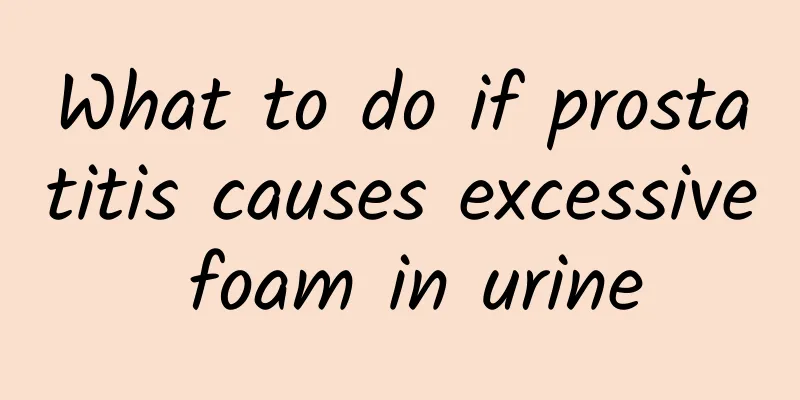What to do if prostatitis causes excessive foam in urine

|
Foamy urine is a symptom that everyone is familiar with. Male friends must be careful when they have foamy urine, because the main cause of foamy urine is prostatitis. We know that prostatitis is a very harmful disease. Prostatitis not only brings us discomfort but also may affect our fertility. Below we will introduce to you what to do when prostatitis causes foamy urine. 1. Antimicrobial therapy The discovery of pathogenic pathogens in prostatic fluid culture is the basis for selecting antibacterial drug treatment. If patients with non-bacterial prostatitis have signs of bacterial infection and general treatment is ineffective, they can also be appropriately treated with antibacterial drugs. When choosing antibacterial drugs, it is necessary to pay attention to the presence of a prostate-blood barrier composed of lipid membranes between the prostate acini and the microcirculation, which hinders the passage of water-soluble antibiotics and greatly reduces the therapeutic effect. When prostate stones are present, the stones can become a shelter for bacteria. The above factors constitute the difficulty in the treatment of chronic bacterial prostatitis, which requires a longer course of treatment and is prone to recurrence. Currently, quinolone drugs such as ofloxacin or levofloxacin are recommended. If ineffective, continue to use it for 8 weeks. If recurrence occurs and the bacterial species remains unchanged, switch to preventive doses to reduce acute attacks and relieve symptoms. If long-term use of antibiotics induces serious side effects, such as pseudomembranous colitis, diarrhea, and the growth of intestinal resistant strains, the treatment plan needs to be changed. Whether non-bacterial prostatitis is suitable for treatment with antibacterial drugs is still controversial in the clinic. Patients with "aseptic" prostatitis can also use drugs that are effective against bacteria and mycoplasmas, such as quinolones, SMZ-TMP or TMP alone, used in combination with tetracycline and quinolones or used intermittently. If antibiotic treatment is ineffective and it is confirmed to be aseptic prostatitis, antibiotic treatment should be discontinued. In addition, using a double balloon catheter to block the prostatic urethra and injecting antibiotic solution from the urethral cavity back into the prostatic duct can also achieve the purpose of treatment. Type I is mainly treated with broad-spectrum antibiotics, symptomatic treatment and supportive treatment. Type II is recommended to be treated with oral antibiotics, and sensitive drugs are selected. The course of treatment is 4-6 weeks, during which the patient should be evaluated for the efficacy. Type III can first take oral antibiotics for 2 to 4 weeks and then evaluate the efficacy. At the same time, non-steroidal anti-inflammatory drugs, α-receptor antagonists, M-receptor antagonists, etc. are used to improve urination symptoms and pain. Type IV does not require treatment. 2. Anti-inflammatory and analgesic drugs Nonsteroidal anti-inflammatory drugs can improve symptoms. Generally, indomethacin is taken orally or in suppositories. Chinese medicine also has certain effects in using anti-inflammatory, heat-clearing, detoxifying, and hardness-softening drugs. Allopurinol can reduce the concentration of uric acid in the whole body and prostatic fluid. Theoretically, as a free radical scavenger, it can also remove active oxygen components, reduce inflammation, and relieve pain. It is an optional auxiliary treatment method. 3. Physical therapy Prostate massage can empty the concentrated secretions in the prostate duct and drain the infection focus in the obstructed area of the gland. Therefore, for stubborn cases, prostate massage can be performed every 3 to 7 days while using antibiotics. A variety of physical factors are used for prostate physiotherapy, such as microwave, radio frequency, ultrashort wave, medium wave and hot water sitz bath, which are beneficial for relaxing the prostate, posterior urethral smooth muscle and pelvic floor muscle, enhancing antibacterial efficacy and relieving pain symptoms. 4.M-receptor antagonists M-receptor antagonists can be used to treat prostatitis in patients with symptoms of overactive bladder such as urgency, frequency, and nocturia but without urinary tract obstruction. 5.α-receptor antagonists Patients with prostatitis, bacterial or non-bacterial prostatitis have increased tension in the prostate, bladder neck and urethral smooth muscles. During urination, the increased pressure in the posterior urethra causes urine to flow back into the prostatic duct, which is an important cause of prostatitis, prostatic stones and bacterial prostatitis. The use of α receptor antagonists can effectively improve prostatitis and urination symptoms, which is important for preventing recurrence of infection. α receptor antagonists should be used for a longer course of treatment to allow enough time to adjust the smooth muscle function and consolidate the therapeutic effect. In the above article, we introduced a common symptom, that is, foam in urine. We recommend that you pay attention to this symptom because it may be caused by prostatitis. The above article introduces in detail what to do if prostatitis causes excessive foam in urine. |
<<: Does prostatitis cause high urine protein?
>>: What causes penis base flaccidity?
Recommend
For the treatment of inguinal flat warts, you can choose these three folk remedies
Nowadays, most people pay much attention to the g...
What kind of short hair should a boy with a high forehead have?
Every boy needs a hairstyle that suits him. A sui...
Penile ureteral itching
There are many reasons for itching of the penis a...
Total PSA
In case the total prostate-specific antigen value...
What medicine should men take for frequent and urgent urination?
Frequent urination and urgency are not only commo...
As soon as the man stretches out his hand, he knows whether it is there or not!
Palmistry, the word "相" has two meaning...
What are the characteristics of the harm of male enhancement drugs to the liver?
Men’s sexual function is not always strong. In ce...
What are the symptoms of kidney deficiency in men?
Kidney deficiency is a relatively common disease,...
Male genital sensitivity can be improved in just three steps
On weekdays, some men will have signs of sexual i...
How is a small belly formed? These three factors are the most common
A small belly is a common condition for women, bu...
Why do men grow beards? Four advantages of growing a beard
Many men are very bothered by their thick beards,...
There are small red spots on the penis
Men must pay attention to proper health care on a...
What is the treatment for chronic prostatitis?
Chronic prostatitis is a disease that is harmful ...
What causes men to ejaculate quickly?
The so-called fast ejaculation is actually premat...
What are male sexual dysfunctions?
There are many diseases related to men. Many men&...









